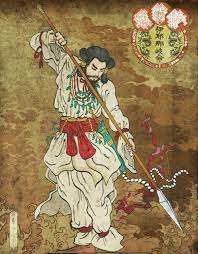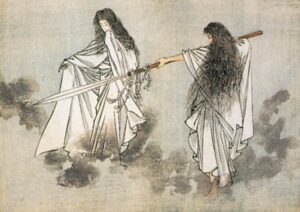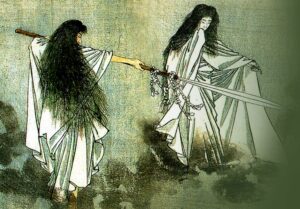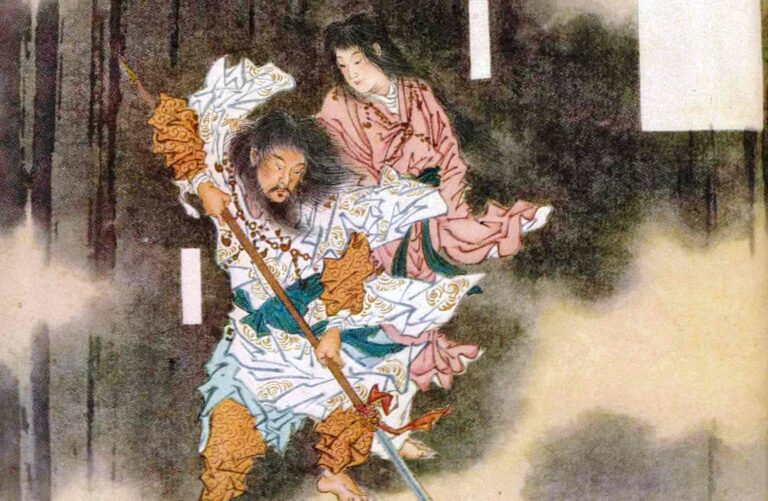Table of Contents
Izanagi, a central figure in Japanese Shinto mythology, is a deity of creation and life. Furthermore, his tales are interwoven into the cultural fabric of Japan, offering profound insights into the spiritual and philosophical underpinnings of Japanese society. This comprehensive exploration delves into Izanagi’s origins, appearance, personality traits, special abilities, and the rich tapestry of myths surrounding him.
In Japanese mythology, Izanagi is one of the principal deities, and he is said to have been born through a process of creation by other divine beings. According to the “Kojiki” and “Nihon Shoki,” which are two of the oldest and most important texts in Japanese mythology and history, Izanagi and his sister Izanami were born when the primordial god, Amenominakanushi, created them.
Origin

The story goes that before the Earth and the heavens existed, there was a formless chaos called “Chaos of the Origin.” From this chaos emerged Amenominakanushi, the first and highest deity in the Shinto pantheon. Subsequently, Amenominakanushi produced two divine beings, Izanagi and Izanami. These two were then tasked with creating the Japanese islands and the world.
Izanagi and Izanami eventually descended to Earth and stood on the Floating Bridge of Heaven (Ame-no-ukihashi). They used a sacred spear to stir the primordial sea, and as they lifted it, the drops that fell from the spear’s tip formed the first Japanese island, Onogoro. The pair then descended to the island and married each other, becoming the first couple.
Their union, however, produced several deformed or misshapen offspring, leading to their separation and the eventual creation of the Japanese islands through a different process. This mythological account serves as the basis for the creation of the Japanese archipelago and is a central story in Shinto mythology. Izanagi and Izanami are considered the progenitors of the Japanese people and are revered in Shintoism as important deities associated with creation and life.
Appearance: A Symbol of Divinity
In Japanese mythology, the ancient texts like the “Kojiki” and “Nihon Shoki” do not provide a detailed description of Izanagi’s appearance. These texts primarily focus on the actions and roles of the deities rather than their physical appearances. However, modern artistic representations often depict Izanagi as a dignified and regal figure. Artists may portray him wearing traditional Japanese attire or robes, and he may be shown holding a sacred spear, which is significant in the creation of the Japanese islands. Like many mythological deities, artists vary in their depictions of Izanagi’s appearance, influenced by their artistic interpretation and cultural context.
Personality

In Japanese mythology, Izanagi is characterized by his role as a creator deity and his interactions with other divine beings, rather than a detailed description of his personality. Nevertheless, certain aspects of his character can be inferred from his actions and the myths in which he is involved. For instance:
Izanagi is portrayed as responsible and purposeful. Working alongside his sister Izanami, he bore the crucial duty of creating the Japanese islands and the world. Consequently, this responsibility underscores a profound sense of purpose in his character as he embarked on this divine mission.
Respectful of Tradition: In the myth of the “Heavenly Rock Cave,” Izanagi demonstrates respect for tradition and ritual. Consequently, after his encounter with the deceased Izanami in the underworld, he strictly adheres to the purification rituals required to cleanse himself of the defilement he acquired in the realm of the dead.
Determined: In his quest to find Izanami in the underworld after her death, Izanagi displays determination and a strong desire to reunite with his beloved sister and partner.
Emotional and Protective: However, after witnessing the horrifying appearance of the deceased Izanami, Izanagi reacts emotionally with fear and shock. Furthermore, he is protective of himself and ultimately leaves the underworld to preserve his own safety.
Creative and Resourceful: Notably, Izanagi’s actions in creating the Japanese islands, using a sacred spear and other means, demonstrate creativity and resourcefulness in fulfilling his divine role.
Special Abilities
In Japanese mythology, Izanagi isn’t typically associated with a wide range of special abilities or supernatural powers as some other mythological figures. However, his significance lies in his role as a creator deity. Notable aspects of his actions and “abilities” include:
Furthermore, Izanagi is known for his strict adherence to purification rituals and traditions. After his encounter with the deceased Izanami in the underworld, he followed specific rituals to purify himself from the defilement he acquired in the realm of the dead. His knowledge of these rituals and his ability to perform them correctly are notable aspects of his character.
Moreover, as a creator deity, Izanagi holds a position of authority and significance in the Shinto pantheon. His actions and decisions shape the world and its divine order, underscoring his role as a powerful figure in Japanese mythology.
The Underworld Saga: A Tale of Love and Perseverance

In the Divine Marriage, brother and sister deities Izanagi and Izanami stood together on the Floating Bridge of Heaven (Ame-no-ukihashi). Using a sacred jeweled spear, they stirred the primordial sea. The drops falling from the spear’s tip formed the first Japanese island, Onogoro, and the couple descended to the island to marry, becoming the first divine couple.
During their union, they gave birth to numerous deities, including islands, elements, and celestial bodies. However, their union also resulted in some deformed and monstrous offspring.
Tragedy struck when Izanami gave birth to the fire deity Kagutsuchi, sustaining grave injuries that led to her death. She descended into the underworld, known as Yomi, associated with death and darkness.
Overwhelmed with grief and longing for his wife, Izanagi decided to journey into Yomi to retrieve Izanami. He prepared by crafting a special comb from a divine tree, using it as a torch to light his way.
Upon reaching the entrance to Yomi, Izanagi encountered Izanami in a horrific state, her body decomposing and infested with demons. Frightened and repulsed, he fled from the underworld.
In a desperate escape, pursued by the enraged and vengeful Izanami, Izanagi managed to flee Yomi. He sealed the entrance with a massive boulder to prevent her return to the living world.
Izanagi, having returned to the land of the living, underwent a purification ritual to cleanse himself from the impurities acquired in the underworld. During this ritual, several deities were born from his actions and belongings, including Amaterasu (the sun goddess) from his left eye, Tsukuyomi (the moon god) from his right eye, and Susanoo (the storm god) from his nose.
Izanagi and the Birth of the Sun, Moon, and Storm
After his terrifying experience in the underworld (Yomi) and his escape from Izanami, Izanagi sought purification in a river. There, he cleansed his body of the impurities acquired in Yomi. As a result, deities were born from different parts of his body. Notably, Amaterasu, the sun goddess, emerged from his left eye, revered as the ruler of the celestial realm. Tsukuyomi, the moon god, was born from his right eye, associated with the moon. Lastly, from his nose, Susanoo, the storm god, emerged, known for his connection to the sea and storms.
These three deities, Amaterasu, Tsukuyomi, and Susanoo, became prominent in the Japanese pantheon, governing aspects of the natural world. Amaterasu symbolizes light, life, and purity, considered the ancestor of the Japanese imperial family. In contrast, Tsukuyomi and Susanoo play distinct roles in Japanese mythology, with Tsukuyomi associating with the moon and night, while Susanoo connects with storms and the sea.
This myth explains the origins of these celestial deities and their roles in the natural order, emphasizing the importance of purification and ritual in Japanese culture and religion. Izanagi’s purification after his journey to the underworld led to the birth of these powerful deities.
Death
According to Japanese mythology, Izanagi eventually passed away. After his journey to the underworld to retrieve his deceased wife, Izanami, and his subsequent purification, he returned to the realm of the living. However, like many figures in mythology, Izanagi’s life story includes a conclusion. The details of his death and the circumstances surrounding it may vary in different versions of Japanese mythology, but it is generally accepted that he did die at some point in the mythological narrative.
Cultural Impact and Legacy
Izanagi, a central figure in Japanese mythology, left a significant cultural impact:
Foundation of Shintoism: Izanagi’s role as a creator deity and involvement in forming Japan is fundamental in Shintoism.
Connection to the Imperial Family: Amaterasu, born from Izanagi’s purification, becomes the ancestor of the Japanese imperial family.
Ritual Purity and Ceremonies: Izanagi’s purification story emphasizes the importance of ritual purity in Japanese culture.
Art and Literature: Figures from Japanese mythology, like Izanagi, inspire traditional art, preserving cultural heritage.
Modern Pop Culture: Japanese mythology, including Izanagi’s tales, influences modern pop culture through various media.
Spiritual Identity: Izanagi and Izanami’s myths explain Japan’s origins, natural phenomena, and life and death.
Preservation of Tradition: Continued reverence of Izanagi and other deities in ceremonies preserves Japan’s cultural and religious traditions.
Izanagi’s legacy shapes Japan’s cultural and spiritual identity through Shintoism, art, and cultural influence.
FAQ
What is Izanagi's significance in Japanese mythology?
Izanagi is considered one of the central deities in Japanese mythology, credited with creating the Japanese archipelago and many other aspects of the world. He is also associated with the concept of purity and ritual in Shintoism.
What is the "Heavenly Rock Cave" myth involving Izanagi?
In this myth, Izanagi descends into the underworld to retrieve his deceased wife, Izanami. However, upon seeing her in a gruesome state, he flees, leading to various consequences and rituals emphasizing purity.
How does Izanagi relate to other deities in Japanese mythology?
Izanagi is the brother and husband of Izanami, with whom he played a crucial role in creating the Japanese islands and various deities. Their descendants include important deities like Amaterasu, the sun goddess, and Susanoo, the god of storms.
What is the significance of Izanagi's actions in creating Japan?
Izanagi's actions in creating Japan with the use of divine tools, such as a sacred spear, emphasize his role as a creative and resourceful deity responsible for shaping the physical world.
How does Izanagi's legacy continue in modern Japanese culture?
Izanagi's myths and stories continue to influence modern Japanese culture, including art, literature, pop culture, and religious practices. His role in the creation of Japan remains an integral part of Japanese identity.
Is Izanagi worshipped in contemporary Shintoism?
Yes, Izanagi is still revered in modern Shintoism, although his worship may not be as prominent as some other deities. He is often invoked in rituals related to purification and creation.
What are some famous artistic representations of Izanagi?
Izanagi is depicted in various traditional art forms such as paintings, sculptures, and theater. These artistic representations often showcase his role as a creator and a divine figure.
Are there any festivals or ceremonies dedicated to Izanagi?
While there may not be specific festivals solely dedicated to Izanagi, he is honored in various Shinto ceremonies, including weddings, to ensure purity and blessings.
How can I learn more about Izanagi and Japanese mythology?
To delve deeper into Izanagi's mythology and Japanese culture, you can explore books, academic resources, museums, and online sources dedicated to Japanese mythology and history.
